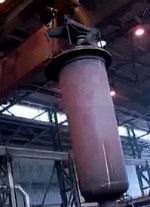- Titanium: element discovery and development
 Reverend William Gregor, 1762—1817
Reverend William Gregor, 1762—1817- The first suspicion of a new, unknown element present in a dark, magnetic iron-sand (ilmenite) in Cornwall (UK) was expressed in 1791 by Gregor, a clergyman and amateur mineralogist. He analyzed some black magnetic sand (menachanite) from Cornwall and found a residue he couldn't identify and thought it might be a new metal.
- Martin Heinrich Klaproth, 1743—1817
 In 1795, Klaproth, a German chemist, analyzed rutile from Hungary and verified an oxide of an unknown element, the same as the one reported by Gregor. He named it Titanium after the Titans Greek mythology, the powerful sons of the Earth in Greek mythology and “the incarnation of natural strength.” However, the element was not successfully isolated until 1910.
In 1795, Klaproth, a German chemist, analyzed rutile from Hungary and verified an oxide of an unknown element, the same as the one reported by Gregor. He named it Titanium after the Titans Greek mythology, the powerful sons of the Earth in Greek mythology and “the incarnation of natural strength.” However, the element was not successfully isolated until 1910.- Matthew A. Hunter
 In 1910 Hunter, an American professor, was the first to make pure elemental titanium. Titanium remained a laboratory curiosity until metallurgist William Kroll invented the Kroll Process in 1946, a technique that enabled titanium production in large quantities. Still, by 1947 only two tonnes of titanium had been produced in the US.
In 1910 Hunter, an American professor, was the first to make pure elemental titanium. Titanium remained a laboratory curiosity until metallurgist William Kroll invented the Kroll Process in 1946, a technique that enabled titanium production in large quantities. Still, by 1947 only two tonnes of titanium had been produced in the US.
- Reverend William Gregor, 1762—1817
 The Titanium Industry was born in 1948 after the US. Government funded the start-up to produce the "strategic" metal for aircraft, missiles and spacecraft. Never before had a structural metal received such scientific, financial and political attention. By 1953, annual production of titanium reached two million pounds.
The Titanium Industry was born in 1948 after the US. Government funded the start-up to produce the "strategic" metal for aircraft, missiles and spacecraft. Never before had a structural metal received such scientific, financial and political attention. By 1953, annual production of titanium reached two million pounds.- Since then, titanium production has grown by about 8% per year, and from the early 1960s as prices dropped, its use shifted significantly from military applications to commercial uses. Still, as of 2006, 72% of titanium metal in the US is utilized for aerospace construction. This high demand by a single industry is the primary reason for the recent surge in titanium prices. The United States imports 99% of its titanium from Russia, Kazakhstan and Japan.
- Today, titanium is utilized in modern applications including aircraft, sports equipment, pigment, corrosion resistant industrial pumps, high performance automobile components, turbine blades, golf clubs, bicycles, eyeglass frames, watches and, of course, jewelry. Learn more: titanium uses
-
About us
Contact us
Make a suggestion
- Metalpedia is a non-profit website, aiming to broaden metal knowledge and provide extensive reference database to users. It provides users reliable information and knowledge to the greatest extent. If there is any copyright violation, please notify us through our contact details to delete such infringement content promptly.
 Reverend William Gregor, 1762—1817
Reverend William Gregor, 1762—1817 In 1795, Klaproth, a German chemist, analyzed rutile from Hungary and verified an oxide of an unknown element, the same as the one reported by Gregor. He named it Titanium after the Titans Greek mythology, the powerful sons of the Earth in Greek mythology and “the incarnation of natural strength.” However, the element was not successfully isolated until 1910.
In 1795, Klaproth, a German chemist, analyzed rutile from Hungary and verified an oxide of an unknown element, the same as the one reported by Gregor. He named it Titanium after the Titans Greek mythology, the powerful sons of the Earth in Greek mythology and “the incarnation of natural strength.” However, the element was not successfully isolated until 1910. In 1910 Hunter, an American professor, was the first to make pure elemental titanium. Titanium remained a laboratory curiosity until metallurgist William Kroll invented the Kroll Process in 1946, a technique that enabled titanium production in large quantities. Still, by 1947 only two tonnes of titanium had been produced in the US.
In 1910 Hunter, an American professor, was the first to make pure elemental titanium. Titanium remained a laboratory curiosity until metallurgist William Kroll invented the Kroll Process in 1946, a technique that enabled titanium production in large quantities. Still, by 1947 only two tonnes of titanium had been produced in the US. The Titanium Industry was born in 1948 after the US. Government funded the start-up to produce the "strategic" metal for aircraft, missiles and spacecraft. Never before had a structural metal received such scientific, financial and political attention. By 1953, annual production of titanium reached two million pounds.
The Titanium Industry was born in 1948 after the US. Government funded the start-up to produce the "strategic" metal for aircraft, missiles and spacecraft. Never before had a structural metal received such scientific, financial and political attention. By 1953, annual production of titanium reached two million pounds.